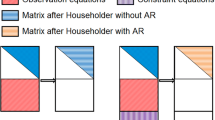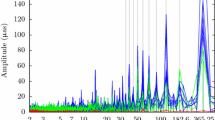Abstract
Resolving the initial phase ambiguities of GPS carrier phase observations was always considered an important aspect of GPS processing techniques. Resolution of the so-called wide-lane ambiguities using a special linear combination of theL 1 andL 2 carrier and code observations has become standard. New aspects have to be considered today: (1) Soon AS, the so-called Anti-Spoofing, will be turned on for all Block II spacecrafts. This means that precise code observations will be no longer available, which in turn means that the mentioned approach to resolve the wide-lane ambiguities will fail. (2) Most encouraging is the establishment of the new International GPS Geodynamics Service (IGS), from where high quality orbits, earth rotation parameters, and eventually also ionospheric models will be available. We are reviewing the ambiguity resolution problem under these new aspects: We look for methods to resolve the initial phase ambiguities without using code observations but using high quality orbits and ionospheric models from IGS, and we study the resolution of the ”narrow-lane ambiguities” (after wide-lane ambiguity resolution) using IGS orbits.
Similar content being viewed by others
References
Beutler G (1992a) The Impact of ”The International GPS Geodynamics Service (IGS)” on the Surveying and Mapping Community, XVII ISPRS Congress, Washington.
Beutler G (1992b) The 1992 Activities of the International GPS Geodynamics Service (IGS), 7th International Symposium on Geodesy and Physics of the Earth, Potsdam.
Bierman G J (1977) Factorization Methods for Discrete Sequential Estimation, Academic, San Diego.
Blewitt G (1989) Carrier Phase Ambiguity Resolution for the Global Positioning System Applied to Geodetic Beselines up to 2000 km. Journal of Geophysical Research. Vol.94 No.B8.
Bock Y, Gourewitch SA, Counselmann CC, King RW, Abbot RI (1986) Interferometric analysis of GPS phase observations. Manuscripta geodaetica, Vol.11, No.4 pp 282–288.
Feissel M (1992) IGS'92 Campaign, Comparison of GPS, SLR, and VLBI Earth Orientation Determinations. IERS Central Bureau, Final Report.
Frei E, Beutler G (1990) Rapid static positioning based on the fast ambiguity resolution approach “FARA”: theory and first results. Manuscripta geodaetica, Vol.15, No.6 pp 325–356.
Goad CC (1985) Precise relative position determination using Global Positioning System carrier phase measurements in nondifference mode. First International Symposium on Precise Positioning with GPS, Rockville.
Goad CC, Mueller A (1988) An automated procedure for generating an optimum set of independent double difference observables using Global Positioning System carrier phase measurements, Manuscripta geodaetica, Vol.13, No.6 pp 365–369.
Gurtner W (1985) GPS-Papers presented by the Astronomical Institute of the University of Berne in the Year 1985. Bern.
McCarthy D (1992) Accuracy of high-frequency observations of earth orientation. 7th International Symposium, IAG Symposium No. 112.
Melbourne WG (1985) The case for ranging in GPS based geodetic system. First International Symposium on Precise Positioning with GPS, Rockville.
Mueller I, Beutler G (1992) The International GPS Service for Geodynamics — development and current structure. Fifth International Symposium on GPS Positioning, Ohio.
Rothacher M, Beutler G, Gurtner W, Brockmann E, Mervart L (1993) Bernese software, version 3.4,Bern.
Wild U, Beutler G, Gurtner W, Rothacher M (1989) Estimating the Ionosphere Using One or More Dual Frequency GPS Receivers. Proceedings of the 5 th International Geodetic Symposium on Satellite Positioning, Las Cruces, New Mexico.
Wübbena G (1985) Software Developments for Geodetic Positioning with GPS Using TI 4100 Code and Carrier Measurements. First International Symposium on Precise Positioning with GPS, Rockville.
Author information
Authors and Affiliations
Rights and permissions
About this article
Cite this article
Mervart, L., Beutler, G., Rothacher, M. et al. Ambiguity resolution strategies using the results of the International GPS Geodynamics Service (IGS). Bulletin Géodésique 68, 29–38 (1994). https://doi.org/10.1007/BF00806750
Received:
Accepted:
Issue Date:
DOI: https://doi.org/10.1007/BF00806750




